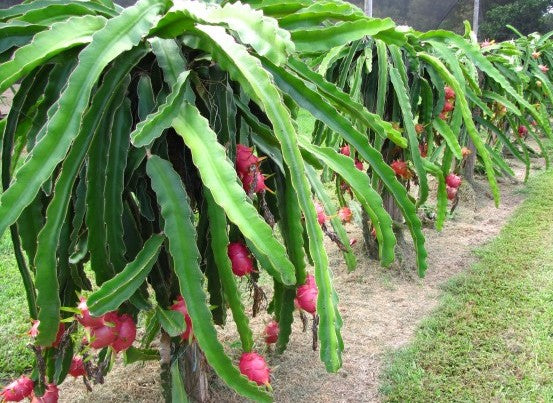
Disease Management in Dragon Fruit
Share
Introduction
Dragon fruit, also known as pitaya, is a tropical fruit prized for its vibrant color, unique shape, and numerous health benefits. However, like any other crop, dragon fruit is susceptible to various diseases that can significantly affect its yield and quality.Effective disease management in dragon fruit is crucial to maintain healthy dragon fruit plants and ensure a productive harvest. This blog will explore common diseases affecting dragon fruit, their symptoms, and the best practices for managing them.

Common Diseases in Dragon Fruit
Anthracnose (Colletotrichum spp.)
Symptoms:
Small, sunken lesions on stems, fruits, and flowers.
Lesions may expand and coalesce, turning dark brown or black.
Infected fruits may show black spots and rot.

Management:
Use disease-free planting material.
Practice good sanitation by removing and destroying infected plant debris.
Apply fungicides like copper-based sprays or Mancozeb at the first sign of disease.
Avoid overhead irrigation to reduce leaf wetness and humidity.

Bacterial Spot (Xanthomonas campestris)
Symptoms:
Water-soaked spots on stems and fruits that turn brown and necrotic.
Spots may enlarge, causing stem cankers and fruit rot.
Wilting and dieback of branches.

Management:
Use disease-free planting material and certified seeds.
Implement crop rotation and avoid planting dragon fruit in previously infected
areas.
Apply copper-based bactericides to control the spread.
Remove and destroy infected plant parts to prevent further spread.
Stem Canker (Neoscytalidium dimidiatum)
Symptoms:
Dark, sunken lesions on the stems that expand and girdle the stem.
Lesions may exude a reddish-brown gum.
In severe cases, cankers can cause stem dieback and plant death.

Management:
Prune and destroy infected stems to prevent the spread.
Apply fungicides such as thiophanate-methyl or benomyl.
Maintain proper spacing between plants to improve air circulation and reduce
humidity.
Avoid wounding plants during cultivation and harvesting.

Integrated Disease Management Strategies
Cultural Practices
Sanitation: Regularly clean and disinfect tools and equipment to prevent the spread of pathogens.
Pruning: Remove and destroy diseased plant parts promptly to reduce inoculum levels.
Irrigation: Use drip irrigation instead of overhead irrigation to minimize leaf wetness and humidity.
Crop Rotation: Rotate dragon fruit with non-host crops to break the life cycle of pathogens.
Biological Control
Beneficial Microorganisms: Introduce beneficial fungi and bacteria, such as Trichoderma spp. and Bacillus subtilis, to the soil to suppress pathogens.
Compost Teas: Apply compost teas to enhance soil health and microbial activity, which can help control diseases.

Chemical Control
Fungicides and Bactericides: Use appropriate fungicides and bactericides as preventive measures and during the early stages of disease development.
Follow label instructions carefully to avoid overuse and resistance buildup.
Soil Treatment: In severe cases, treat the soil with fumigants to eliminate persistent soil-borne pathogens.
Monitoring and Early Detection
Regular monitoring and early detection are key components of effective disease
management. Conduct weekly inspections of your dragon fruit plants, paying close attention to any signs of disease. Early intervention can significantly reduce the impact of diseases and improve overall plant health.
Conclusion
Managing diseases in dragon fruit requires a holistic approach that combines cultural,biological, and chemical control methods. By understanding the common diseases affecting dragon fruit and implementing effective management strategies, you can ensure a healthy and productive crop. Regular monitoring, good sanitation practices,and timely interventions are crucial to keeping your dragon fruit plants disease-free and thriving.Implement these practices to protect your dragon fruit crop, and enjoy the numeroushealth benefits and unique favors that this remarkable fruit offers.
